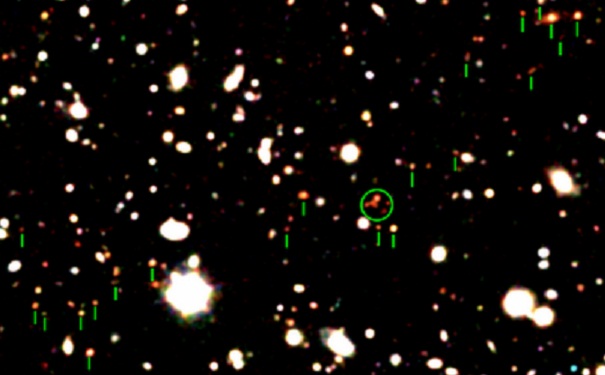
Images in the optical wavelength (from the Hubble Space Telescope) and the near-infrared (from FourStar/Magellan). Credit: FourStar Galaxy Evolution Survey
Astronomers have discovered the most distant example of a galaxy cluster.
The cluster, located 10.5 billion light-years away from the Milky Way, and it is made up of a dense concentration of 30 galaxies. “Our galaxy cluster is observed when our universe was only three billion years old,” said Swinburne University of Technology astrophysicist Dr Lee Spitler, lead author of the study FourStar Galaxy Evolution Survey.
“This means it is still young and should continue to grow into an extremely dense structure containing many more galaxies,” he said.
The cluster is actually located in the middle of a region that has been carefully examined for thousands of hours. Astronomers had observed the 30 galaxies before, but didn’t have the critical distance information that suggested they were connected.
Spitler and his colleagues used the FourStar camera on the Magellan 6.5 metre telescope in Chile and five specially designed infra-red camera filters to map out the distances to all galaxies in a small region on the sky. The filters act together like specialised sunglasses that filter out nearly all light, except the one that is coming from objects a certain distance away.
“So if you are standing in a forest with a pair of sunglasses tuned to light coming from objects 50 metres distant, you’ll only see trees 50 metres away,” Spitler said. “If you put on another pair of sunglasses tuned to 45 metres you’ll see another set of trees 45 metres away.
“If you continue changing the distance of your sunglasses, you’ll eventually have a 3D map of the trees around you.”
The 3D map showed the 30 galaxies at approximately the same distance in a very compact region of the sky. This suggested that they are most likely physically related to each other via gravitational forces and make up a dense galaxy cluster.
The discovery of a cluster at such an early stage of the Universe will also help scientists understand how galaxies are influenced by their environment. While the Milky Way isn’t currently located within a cluster galaxy, some astronomers believe it is being pulled towards the galaxy cluster Virgo and could possibly fall into it many billions of years from now.
This would have important consequences: for example, all star-formation could stop because gas is stripped away as it falls in. “That is why studying a very, very distant cluster is interesting: we are trying to understand how a galaxy falling into a cluster is transformed.”
The astronomers are now collecting data to determine the age and fundamental chemistry of the cluster; they want to determine when the galaxies fell into the cluster and if any properties have changed.






